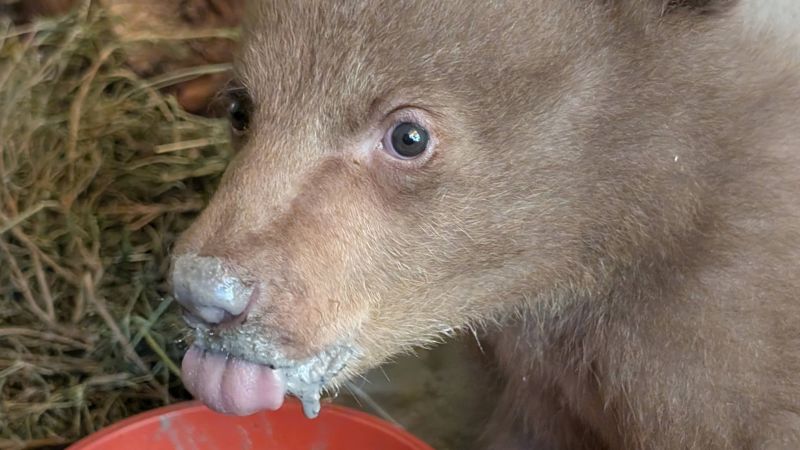In a heartwarming yet unconventional approach to wildlife rehabilitation, caretakers at the San Diego Humane Society don costumes that include gloves, a fur coat, and a bear mask as they tend to a young, orphaned black bear cub. This peculiar ensemble may sound like a trendy fashion statement, but it serves a pivotal role in the care of the cub, which was discovered in April by campers in California’s picturesque Los Padres National Forest. After extensive efforts by biologists from the California Department of Fish and Wildlife to locate the cub’s mother yielded no results, the San Diego Humane Society stepped in to provide care.
The little bear, who was just shy of two months old when he arrived at the facility, is notably the youngest black bear ever entrusted to the care of the San Diego Humane Society, according to Autumn Welch, the wildlife operations manager and one of the bear’s primary caregivers. This age is critical; usually, cubs that young remain in the safety of their mother’s presence, and without her nurture, survival is nearly impossible. Welch anticipates that the little cub will require about a year of rehabilitation before he is ready to be reintroduced into the wild.
The underlying objective of the caregivers is to eventually release the cub back into its natural habitat. The unique attire worn by caretakers is intended to minimize the risk of the cub developing an imprinting relationship with humans, which could hinder its ability to survive in the wild. Welch has explained that even though they may look like a scene out of a children’s movie, the costumes serve a practical purpose—reducing the chances of the cub recognizing humans as caregivers.
But the effectiveness of the bear disguises has raised questions. Do these costumes truly convince the cub that he is being looked after by other bears? Welch asserts that they indeed do. A recent test performed by caregivers indicated that when they entered the cub’s enclosure without the costume, he reacted by climbing a tree in fear, a behavior that is precisely what they aim for, as it suggests that he perceives them as potential threats, not as companions.
The costumes are comprised of real fur coats donated specifically for this purpose, and the masks are designed to enhance the realism of their appearance. Caregivers go to great lengths to ensure that the furs maintain the distinct scent of black bears. For instance, the fur coats are stored in sealed containers with hay collected from a nearby wildlife sanctuary that also houses bears, thereby adding an authentic touch to the scent and making the caregivers appear more like maternal figures to the cub.
However, Welch contemplates whether the cub identifies them as surrogate mothers or more as playful siblings, given that he interacts with them in a relaxed manner. The cub has an enclosure equipped with various elements to stimulate his natural instincts, including donated furs, black bear-scented hay, and trees, ensuring he has plenty of space to climb and explore, simulating a natural nurturing environment.
His favorite spot is to snuggle against one of the larger teddy bears, which Welch believes offers him comfort akin to that of a mother bear. As a result, during periods when the caregivers are not around, the cub often seeks refuge beside the stuffed bear, displaying behaviors that are reminiscent of mother-cub interactions in the wild.
The caregivers utilize their time with the cub to instill in him the survival skills that he would most likely have learned from his mother, including climbing techniques, foraging for food, and identifying safe nesting spots. Witnessing the cub reach various important milestones, such as foraging for insects and successfully consuming them, has been a rewarding experience for the staff.
The concept of caregivers dressing in animal costumes is not unique to the San Diego Humane Society. Similar practices have been observed at wildlife rehabilitation facilities across the globe, including a wildlife center in Virginia that used a fox mask for an orphaned kit and one in South Africa that utilized a crane costume. Welch confirmed that this method is also advantageous when caring for baby raccoons and coyote pups, emphasizing the importance of maintaining a wild animal’s instinctual behaviors in a controlled setting.
As they manage to care for such a rare young bear, the San Diego Humane Society has found itself faced with extensive needs for supplies, including the specialized bear masks, with the projected cost for this year’s care reaching approximately $72,000. Ultimately, Welch remarked, “It’s a labor of love.” The team is dedicated to helping this young bear thrive and eventually return to the wild, seeing it as an invaluable experience that underscores the importance of wildlife rehabilitation.



